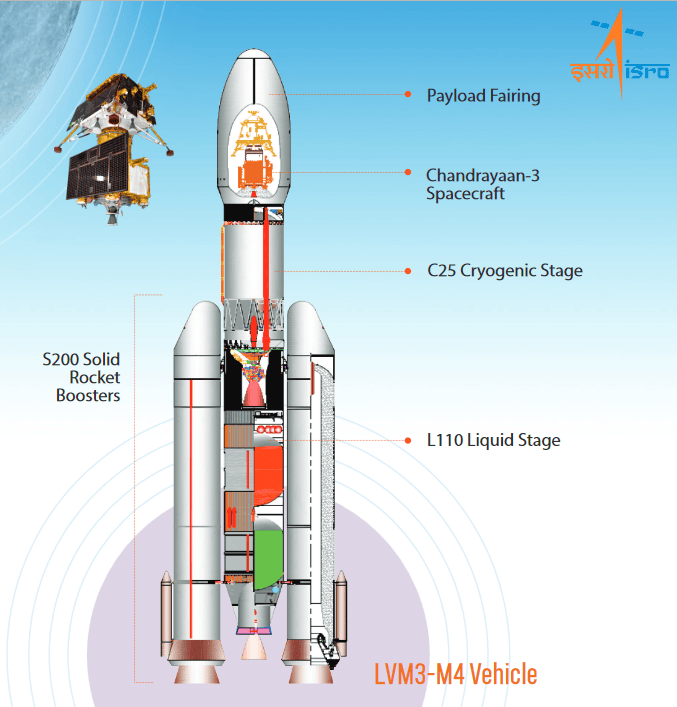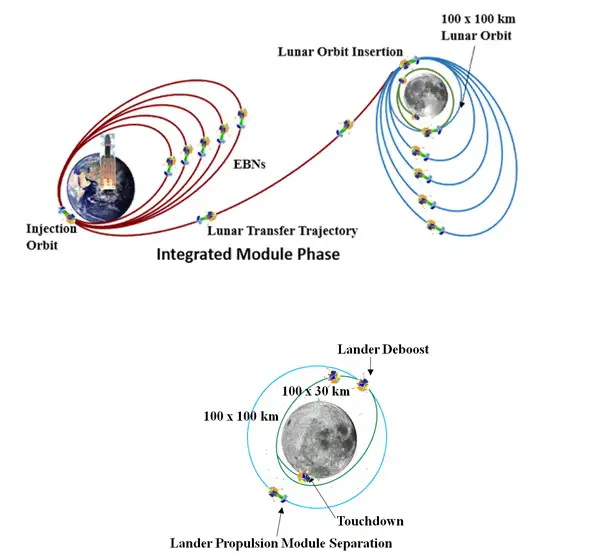Chandrayaan-3
Table of Contents
Introduction
Chandrayaan-3 is the third Moon’s mission by the Indian Space Research Organisation (ISRO). It is a follow-on mission to Chandrayaan-2 to demonstrate end-to-end capability in safe landing and roving on the lunar surface. It consists of a lander and the Pragyan rover configuration.

The launch of Chandrayaan-3 took place at 14 July 2023, at 2:35 pm, by LVM3 from SDSC (Satish Dhawan Space Centre) SHAR, Sriharikota.
Rocket Sequence :
| Event | Flight Time (s) | Altitude (km) | Inertial Velocity (km/s) |
|---|---|---|---|
| 2xS200 Ignition | 0.00 | 0.024 | 0.452 |
| L110 Ignition | 108.10 | 44.668 | 1.788 |
| 2xS200 Separation | 127.00 | 62.171 | 1.969 |
| PLF Separation | 194.96 | 114.805 | 2.560 |
| L110 Separation | 305.56 | 175.352 | 4.623 |
| C25 Ignition | 307.96 | 176.573 | 4.621 |
| C25 Shut-off | 954.42 | 174.695 | 10.242 |
| Satellite Separation | 969.42 | 179.192 | 10.269 |

Mission Objectives
- To demonstrate Safe and Soft Landing on Lunar Surface
- To demonstrate Rover roving on the moon
- To conduct in-situ scientific experiments
The objectives of scientific payloads planned on Chandrayaan-3 Lander Module and Rover are :
| Sl. No | Lander Payloads | Objectives |
|---|---|---|
| 1. | Radio Anatomy of Moon Bound Hypersensitive ionosphere and Atmosphere (RAMBHA) | To measure the near surface plasma (ions and electrons) density and its changes with time |
| 2. | Chandra’s Surface Thermo physical Experiment (ChaSTE) | To carry out the measurements of thermal properties of lunar surface near polar region. |
| 3. | Instrument for Lunar Seismic Activity (ILSA) | To measure seismicity around the landing site and delineating the structure of the lunar crust and mantle. |
| 4. | LASER Retroreflector Array (LRA) | It is a passive experiment to understand the dynamics of Moon system. |
| Sl. No | Rover Payloads | Objectives |
|---|---|---|
| 1. | LASER Induced Breakdown Spectroscope (LIBS) | Qualitative and quantitative elemental analysis & To derive the chemical Composition and infer mineralogical composition to further our understanding of Lunar-surface. |
| 2. | Alpha Particle X-ray Spectrometer (APXS) | To determine the elemental composition (Mg, Al, Si, K, Ca,Ti, Fe) of Lunar soil and rocks around the lunar landing site. |
| Sl. No | Propulsion Module Payload | Objectives |
|---|---|---|
| 1. | Spectro-polarimetry of HAbitable Planet Earth (SHAPE) | Future discoveries of smaller planets in reflected light would allow us to probe into variety of Exo-planets which would qualify for habitability (or for presence of life). |
Chandrayaan-3 Specifications
| Sl No. | Parameter | Specifications |
|---|---|---|
| 1. | Mission Life (Lander & Rover) | One lunar day (~14 Earth days) |
| 2. | Landing Site (Prime) | 4 km x 2.4 km 69.367621 S, 32.348126 E |
| 3. | Science Payloads | Lander: Radio Anatomy of Moon Bound Hypersensitive ionosphere and Atmosphere (RAMBHA) Chandra’s Surface Thermo physical Experiment (ChaSTE) Instrument for Lunar Seismic Activity (ILSA) Laser Retroreflector Array (LRA) Rover: Alpha Particle X-Ray Spectrometer (APXS) Laser Induced Breakdown Spectroscope (LIBS) Propulsion Module: Spectro-polarimetry of HAbitable Planet Earth (SHAPE) |
| 4. | Two Module Configuration | Propulsion Module (Carries Lander from launch injection to Lunar orbit) Lander Module (Rover is accommodated inside the Lander) |
| 5. | Mass | Propulsion Module: 2148 kg Lander Module: 1752 kg including Rover of 26 kg Total: 3900 kg |
| 6. | Power generation | Propulsion Module: 758 W Lander Module: 738W, WS with Bias Rover: 50W |
| 7. | Communication | Propulsion Module: Communicates with IDSN Lander Module: Communicates with IDSN and Rover. Chandrayaan-2 Orbiter is also planned for contingency link. Rover: Communicates only with Lander. |
| 8. | Lander Sensors | Laser Inertial Referencing and Accelerometer Package (LIRAP) Ka-Band Altimeter (KaRA) Lander Position Detection Camera (LPDC) LHDAC (Lander Hazard Detection & Avoidance Camera) Laser Altimeter (LASA) Laser Doppler Velocimeter (LDV) Lander Horizontal Velocity Camera (LHVC) Micro Star sensor Inclinometer & Touchdown sensors |
| 9. | Lander Actuators | Reaction wheels – 4 nos (10 Nms & 0.1 Nm) |
| 10. | Lander Propulsion System | Bi-Propellant Propulsion System (MMH + MON3), 4 nos. of 800 N Throttleable engines & 8 nos. of 58 N; Throttleable Engine Control Electronics |
| 11. | Lander Mechanisms | Lander leg Rover Ramp (Primary & Secondary) Rover ILSA, Rambha & Chaste Payloads Umbilical connector Protection Mechanism, X- Band Antenna |
| 12. | Lander Touchdown specifications | Vertical velocity: ≤ 2 m / sec Horizontal velocity: ≤ 0.5 m / sec Slope: ≤ 120 |

